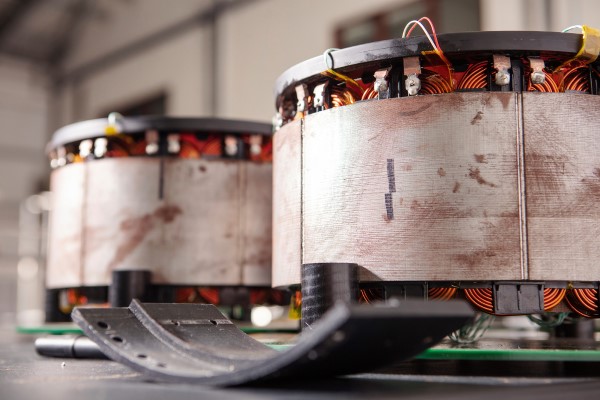Our vision for a net zero world - the future of sustainable propulsion
19 October 2022 | By: Newcastle University | 2 min read
The redeveloped Stephenson building will host three extraordinary hubs for research and collaboration; digital manufacturing, sustainable propulsion, and biomedical engineering.
Academic Director for electrification, Professor Roberto Palacin talks to us about the University’s vision for sustainable propulsion.
The Stephenson building – the home of collaboration
Newcastle University strives for world-class academic excellence, working not only on the supply side of knowledge creation and dissemination but also by responding to the demands of societal challenges.
We are placed in the top 100 in the world for action on sustainable development in the latest 2024 Times Higher Education Impact Rankings.
The Stephenson building is the latest piece in this jigsaw, bringing together educational and research facilities that draw from the internationally leading teams at Newcastle University tackling decarbonisation, including propulsion.
The building has been conceived as a collaborative space for academics, students and industrial partners to work together to develop the technology solutions needed. It will also develop a new generation of engineers equipped with the skills demanded by industry to meet the challenges we are facing.
-1.jpg?width=800&name=Stephenson_Building_Dusk_View%20(featured%20image)-1.jpg)
Commitment to sustainability
Newcastle University is committed to making the world a greener, healthier place to live.
We influence policy, industry, communities and jurisdictions to adopt sustainable practices every day, and constantly strive towards achieving the United Nations’ Sustainable Development Goals (SDGs).
Newcastle University is host to a number of sustainability-related national centres, such as the National Innovation Centre for Data (NICD) and the UKRI GCRF Water Security and Sustainable Development Hub.
We’re also home to some truly unique facilities like the Urban Observatory, which collects and visualises the largest set of publicly available real-time urban data in the UK, and an industrialisation centre for the development of next generation electrical machines (Driving the Electric Revolution Industrialisation Centres).
Newcastle is also home to a series of Centres of Research Excellence (NUCoREs) focusing on multidisciplinary research, such as the Centre for Climate and Environmental Resilience and the Centre for Mobility and Transport.
The latest and perhaps most exciting addition is the redeveloped Stephenson building, the home of Engineering at Newcastle.
Propulsion and Climate Change
Decarbonisation, net zero, and carbon footprint are all too familiar and perhaps overused terms that nonetheless capture the crux of our biggest challenge as a society and a species on the planet: To mitigate and minimise the damaging effects of climate change.
Propulsion is associated with movement and power which in turn relates to transport but also manufacturing, energy and all those key pillars in our way of life.
In its basic form, a propulsion system is comprised of a prime mover generating the power, such as an internal combustion engine (ICE) and a transmission system e.g. gears and shafts to transform that power into movement.

Discovering carbon-neutral solutions
Finding solutions that are carbon neutral and sustainable involve not only replacing fossil-fuel based prime movers with other types, such as batteries or hydrogen fuel cells, but also developing incredibly efficient transmission systems that can harness the vast power generated by these alternative motors. Indeed, electric motors can deliver maximum power almost instantaneously which requires a mindset shift when engineering their transmission systems.
Sustainability doesn’t stop here. It also involves other key aspects, such as the replacement of rare earth metals as part of the design and manufacturing process for such machines.
We have a vision of sustainable propulsion that draws from a range of clean power sources. We want to lead transformative research and education that develops new ways of thinking how we transition to clean propulsion.
Education and research
The new Stephenson building is at the heart of Newcastle University's efforts in bringing state-of-the-art educational and research facilities to tackle global challenges such as decarbonisation.
The site is linked to other key facilities, like the newly launched Advanced Engineering Research Hub (AERH) and the Driving the Electric Revolution Industrialisation Centre (DER-IC), both unique research and innovation spaces.
These include, for example, a state-of-the-art propulsion systems facility equipped with a twin 1.2+1.2MW dynamic drivetrain. This enables the development and validation of power transmission systems, including an environmental test capability. This means that these tests can be conducted in extreme conditions in the -40 to 140oC range. This is significant as there is a marked performance variation depending on ambient and operational temperature. The lab is part of the £94M UK Rail Research Innovation Network (UKRRIN) of which Newcastle is a founding member.
Similarly, DER-IC is a nationwide project focusing on bridging academia and industry collaboration to develop supply chains in power electronics, machines and drives (PEMD) underpinned by sustainability principles. Newcastle University is leading the Northeast IC and coordinating the national scheme.
Looking to the future
Developed in two phases, summer 2023 will see phase 1 of the Stephenson building completed with the opening of the main labs and teaching facilities followed by the completion of the refurbishment of the original 1940s-built part in Summer 2024.
Everyone involved with engineering education at Newcastle are looking forward to this new era of exciting knowledge development. We’ll be applying the very same principles that instigated those pioneers in 1871, to underpin the economy of the region, the nation and globally. This is our purpose, and it's as relevant today as it was back then.